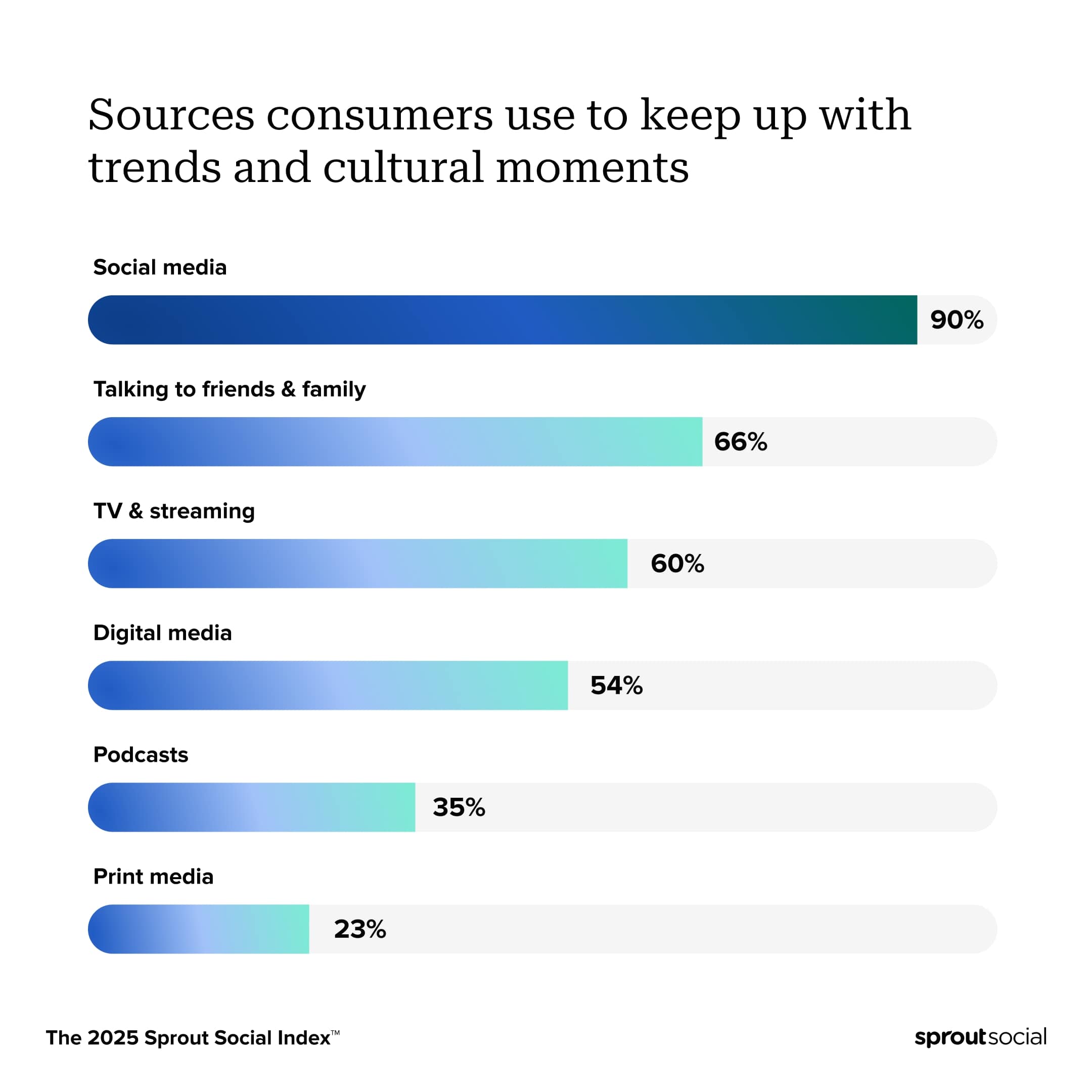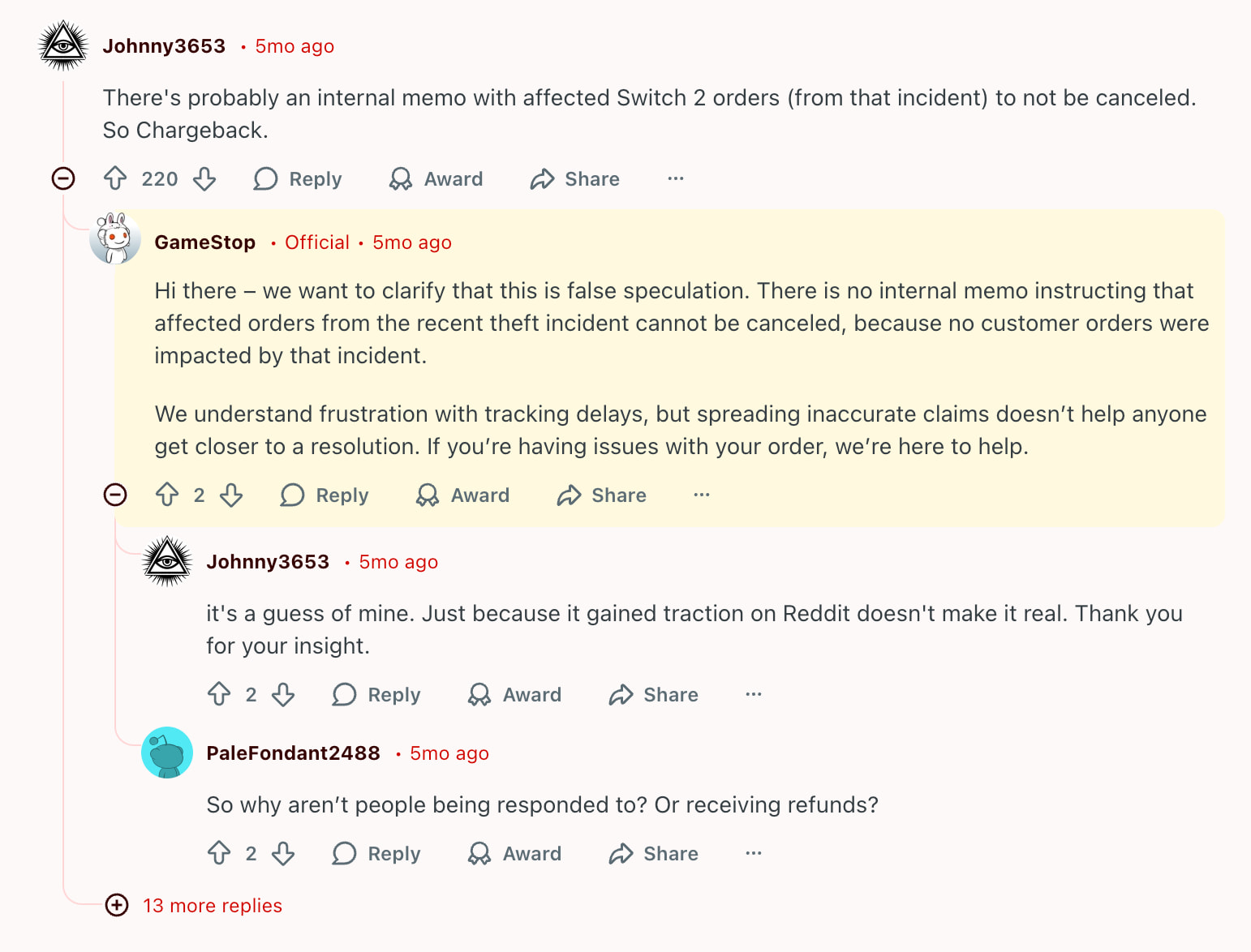Corporate reputation management: How to use social listening to protect and build brand trust

Table of Contents
You spend years managing a vibrant, positive brand reputation—nailing the customer experience, delivering great service and watching your reputation thrive. But all it takes is one viral post to make all that hard work feel like it’s disappearing overnight.
Even the most experienced marketers face this reality. According to an Axios Harris Poll, 46% of corporate reputations have declined between 2019 and 2025.
Managing online sentiment can feel overwhelming, but you can take control of your brand’s narrative with a smart corporate reputation management strategy.
What is corporate reputation management?
Corporate reputation management is the practice of proactively influencing and maintaining how the public perceives your brand. This includes monitoring conversations about your company, resolving issues quickly and amplifying positive moments to shape your brand perception.
Corporate reputation management and online reputation management go hand-in-hand. For modern brands, the key aspect that sets them apart is the online focus, which highlights how digital conversations shape brand perception and how customers expect you to be actively listening on social.
According to the Sprout Social Index™ 2025, 93% of customers say brands must keep up with online culture. People share their experiences on X, Facebook, Instagram and in communities like Reddit—and these conversations directly impact your brand. In fact, the Index also found that 90% of consumers use social media to keep up with key moments. This is why social media teams are on the front lines, tasked with protecting and nurturing brand reputation.

Want a great real-life example of keeping up with online culture? Look at the 2018 #ChickenCrises. When KFC ran out of chicken and had to shut down over 750 stores, customers were not happy. Using social listening, the brand quickly addressed the issue with an edgy, self-aware response. They rearranged the letters “KFC” on a chicken bucket to look like a curse word, essentially saying: “We messed up.”
This light-hearted, authentic response defused tension, protected the brand’s reputation and sparked viral trends. It reinforces how vital it is for social media professionals to listen, engage and collaborate with stakeholders to manage reputation challenges before they escalate.
Trust impacts everyone from consumers to investors (63% cite it as a critical factor in business-related decisions, according to the Phillips Group). As a marketing leader, your opportunity is to proactively build and protect corporate reputation by engaging with audience conversations and influencing your company’s narrative, wherever it happens.
Why corporate reputation management is important today
Your reputation shapes every part of your business, from winning stakeholder trust to driving sales and building customer loyalty. Because reputation is foundational to brand health, damage to it is one of the biggest risks companies face today.
The classic Harvard Business Review’s Reputation and Its Risks, notes that 70-80% of the modern economy’s market value comes from “hard-to-assess intangible assets,” like brand equity. This means anything that can hinder your brand—a bad reputation, a crisis—has the power to affect your entire business. Modern data confirms this: Aon’s findings rank reputation damage as the eighth biggest risk to companies worldwide.
But even when you do everything right, outside factors may still influence your reputation. In 2025, a user on Reddit reported that GameStop had charged customers for unreceived products following a $1.4 million merchandise heist.
Rather than letting the issue escalate, though, GameStop’s social media team acted quickly with a proactive response that clarified that no customer orders were affected. This action helped the company protect its reputation and maintain brand trust.

Source: Reddit
GameStop’s social media response made the difference between protecting its reputation and letting a false story spread unchecked. Their social team listened, researched the facts and responded quickly with clarity—a move that preserved brand trust.
By spotting issues early and responding quickly, your company reduces the impact of negative reputation events. But reputation management is more than avoiding the negative. As a marketer, you also have the ability to proactively nurture your brand perception online to highlight positive stories and experiences.
Real-world examples like GameStop show why fast, authentic engagement matters just as much as monitoring, because every interaction shapes perception. Matt Bowman, CEO and founder of Thrive Local, works with businesses to manage their online reputation. In his case, one of his clients received a Facebook complaint about a missed appointment.
After receiving alerts within six minutes, the team worked to reschedule and offer credit. Because of the fast engagement, Bowman said, “the customer later edited the post to highlight the fast resolution and the thread stalled before it spread further.” These speedy strategies and complaint management process helped increase the brand’s reputation on Google and improved its online reviews from, 4.2 stars to 4.4.
The benefits of positive corporate reputations
Reputation management should be a pillar of your marketing strategy because it directly increases brand value and business performance. When your target audience views you positively and trusts your brand, they’re more likely to purchase and spread the word.
Through key statistics about positive corporate reputations and social media’s role in them, you learn three core principles:
- Customers value proactive strategies that foster trust and uphold their values.
- Audiences expect you to understand their frustrations, needs and desires.
- The market rewards brands that are present, listening and approachable.
Here’s what the data says:
Audiences value trust
According to the Sprout Social Index, 93% of customers feel companies should address misinformation more actively. By staying on top of perceptions about your brand and the issues your audience cares about, you’ll significantly increase company trust.
Trust starts with listening. Your social media team can strengthen this process by monitoring brand conversations daily using social listening tools that track mentions, identify misinformation and spot frustrations early.
Social media users expect fast engagement
The Index also found that 73% of users will choose another company if a brand doesn’t reply to them on social media. Interacting with customers on their preferred networks helps you join the conversation, spot issues early and find positive opportunities to highlight.
To realize the benefits of fast engagement, start by setting clear response time goals—aim to respond within a few hours. If it’s after-hours, include an auto-response to let the person know you’ll get back to them ASAP.
The right social media management tools make this easier. A social media platform helps centralize comments, mentions and DMs in one place so nothing slips through the cracks. Combining these features with clear workflows and response templates allows your social media team to respond faster.
Brand presence directly influences revenue
Businesses that establish a relevant online presence often see their revenue increase. For example, storefronts that established themselves on Yelp saw an average revenue increase of 5%. By nurturing your online presence through social listening and connecting with your audience, you can proactively lead and influence conversations about your brand.
Improve your brand presence by turning awareness into growth. Post regularly and share content that supports your brand’s story and aligns with your customers’ goals.
Social listening insights help you identify emerging trends and customer needs, allowing you to create relevant and timely content. Over time, you can measure your growth through social media analytics and tie your improved brand reputation with real results.
How to manage your brand’s corporate reputation
Managing corporate reputation requires a proactive, always-on approach. Here are some best practices to implement to protect your brand image.
1. Monitor and listen daily
Daily monitoring across all brand channels helps you gauge what audiences are saying about you online. By setting up alerts for keywords (like your brand and product names) and tracking key metrics, you’ll be able to measure how customers feel about you.
While manual monitoring is important for engagement, it’s impossible to manage your reputation alone. Listening and monitoring tools provide the automation to canvas your brand sentiment across all social channels. For example, you can create listening queries to track conversations around topics and your brand, setting up alerts for keywords and hashtags so you know about a pressing issue right away and can engage immediately.
For pressing issues, speed is the ultimate difference between a crisis spiraling out of control and a well-managed reputation. When a user posts about your brand, your social media team can quickly step in to manage the issue by responding with empathy and a potential solution.
Leah Miller, a marketing strategist at Versys Media, shared a story about a DTC brand facing negative sentiment due to delayed orders—before customer service had even noticed.
“Through social listening, we spotted clusters of frustrated tweets and Reddit threads by day two,” Miller says. “The brand quickly posted an acknowledgment, emailed all affected customers with a discount and opened dedicated support lines. Without social listening, the team would have been blindsided days later when complaints multiplied.”
As your team addresses concerns, use Sprout Social’s analytics tools to measure relevant KPIs and turn them into action. Performance, network and post-performance reports help you tie reputation improvements to business outcomes. Additionally, Premium Analytics, Sprout’s add-on analytics solution includes AI-powered help and advanced customizations to predict spikes in negative sentiment and identify recurring complaints.
2. Engage and respond with authenticity
Managing your corporate reputation requires you to talk to your customers and audiences. When you find an opportunity—whether to highlight a positive moment or protect your brand—be sure to engage in the conversation.
One way to engage authentically is to personalize each response. Use the customer’s name and reference specific details from their message to show genuine care and empathy.
As a social media professional, using communication tools will unify your incoming and outgoing messages, helping to nurture conversations that protect your public image. To manage engagement, set up approval workflows within your social media management tool, assigning clear roles and permissions for publishing and engagement.
Additionally, use approval filters to review sensitive messages and cases, protecting your reputation management process. Over time, you can measure your team’s performance and communicate progress with stakeholders.
3. Prepare for crises
No matter how strong your reputation is, something will test it eventually. It could be an internal issue (like an upset former employee) or an external factor (like a poor customer experience). Either way, be sure you have a clear plan in place. Listening helps flag an issue and your crisis plan helps you respond and resolve it quickly, especially when you have a social media newsroom model in place to centralize inputs and guide the response.
Planning ahead gives you the clarity and speed you need when a reputation risk arises. Start by developing a crisis communication plan that outlines clear roles, responsibilities and next steps.
Define an approval process that identifies who leads communication efforts, who signs off on messaging and how updates will be shared internally. These structures ensure faster decision-making and a unified response when it matters most.
Then, address the issue head-on. Acknowledge what happened honestly and explain how you plan to fix it. It’s okay to admit where you went wrong—customers value authenticity. After publishing the official response, connect with individual users who need personal attention.
Finally, learn your lessons and integrate the solution. Make your realignment part of your social and reputation strategy so the issue doesn’t happen again. Use listening to identify keywords associated with the issue, then measure your progress.
4. Measure sentiment and reputation impact
As you manage your reputation, be sure to track your progress. Have your team use social listening and sentiment analysis to gauge reputation health and spot opportunities for improvement .
Helpful KPIs for corporate reputation include:
- Positive vs. negative brand mentions to evaluate your overall brand reputation
- Average review ratings to study the end-to-end customer experience
- Net Promoter Score (NPS) to analyze customer loyalty and sentiment
- Share of voice compared to competitors to evaluate reputation and awareness growth (if positive)
- Sentiment trajectory to measure long-term improvements in brand reputation
- Crises recovery velocity to assess how effective your social media response is during a crisis
- Customer churn and retention rates to report the overall impact on brand reputation to stakeholders
Be sure to compile useful data with analytics, like mentions and engagement, across all of your networks.
By having your sentiment metrics in one place, you’ll be able to easily generate reports for your stakeholders and tie those results to your business operations and goals. Once you see reputation improvements, you can then correlate the sentiment with increases in conversions, leads, higher customer lifetime value and more.
How to build your own successful corporate reputation management strategy
Starting your own online reputation management program begins with assessing your current reputation. Use social listening to monitor what people are saying about your brand across social media. Then use that baseline as a starting point to set goals and measure progress.
A great way to assess your reputation is with a 1-10 ranking system. Use online sentiment analysis to classify your top mentions with a basic ranking:
- 1-2 is very negative
- 3-4 is negative
- 5 is neutral
- 6-7 is slightly positive
- 8-10 is very positive
Average your sentiment scores for your baseline. Once you have the score, create a clear goal for improvement (e.g., moving from a 5 to a 7).
For a more in-depth sentiment analysis, segment your scores by influential audiences, geographical trends and message virality. This helps you create a more defined and targeted approach to improving your reputation across different communities.
As you work to improve your reputation, continually monitor brand mentions, conversations and relevant trends. This allows you to measure progress in real-time and jump into conversations when you need to influence your brand image. Use social media analytics to attribute progress to your work and report it to stakeholders.
Even with a daily and long-term strategy, you have to prepare for the inevitable: crises will come. An Adweek article puts it well: “A brand’s response to a crisis can define public perception for years.” Preparation makes the difference between controlling the effect on your brand and letting it go wild.
Prepare by creating a crisis management plan. Outline a clear protocol for urgent situations, defining actions, roles, approvals and communication steps to keep your team aligned. Approval workflows and communication controls help simplify team reviews, allowing you to respond quickly and effectively. Additionally, run scenarios and simulations with your team to learn practical lessons and prepare them for real-life situations.
Build a positive corporate reputation with Sprout Social
Corporate reputation management is inextricably linked to online culture, making it a critical part of your marketing strategy. A good reputation drives stronger brand equity, higher trust and company growth. Social conversations happen fast and trying to track them manually leaves your team vulnerable to unmanaged risks.
That’s where a unified approach comes in. With Sprout Social, you can bring all your channels together and use Listening to find and nurture conversations that shape your reputation.
Schedule a demo today to see how Sprout and its tools, like Listening and Smart Inbox, will help you build a positive image and a winning reputation for your business.
Corporate reputation management FAQs
How can my business pick the best online reputation management tool to protect our brand?
To find the right reputation management tool, identify your needs first. For example, if you need a multi-channel social media monitoring and collaboration solution, use Sprout Social to unify your social media networks in one place. It allows you to actively listen in on customers and audience members, schedule and publish posts and engage with users in one place.
What features should I look for when comparing online reputation management software for big companies?
You should prioritize social listening. These capabilities help you spot risks early and uncover growth opportunities. Here are a few key features that Sprout provides:
- Smart Inbox: Find conversations based on keywords, prioritize messages, leverage history message management and collaborate with your team to engage with social media users.
- Listening queries: Track millions of conversations around topics that are relevant to your brand and market.
- AI-powered analytics: Use AI and automation to collect and study listening queries for insights and sentiments using filters, keywords and smart categories.
How can marketing leaders measure the ROI of corporate reputation management initiatives?
Start with marketing metrics to measure how your reputation has improved in the areas you’re responsible for. Use the following KPIs:
- Sentiment score to track what customers feel about your brand
- Average star rating to measure the end-to-end customer purchase experience and to preemptively identify frustrations within your review management program
- Share of positive mentions to analyze improvement in word of mouth and satisfaction
- Brand favorability survey results to study your overall efforts over time
- Social media engagement to measure positive improvements in customer interactions
What are the best tools for corporate reputation management?
The best corporate reputation management solutions bring you closer to your audience and Sprout Social does exactly that. With all your channels unified in one platform, you can monitor conversations, respond quickly and manage brand sentiment across networks like Instagram, LinkedIn, Reddit and X.


Share